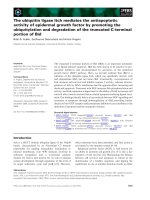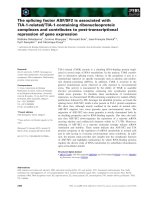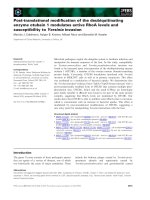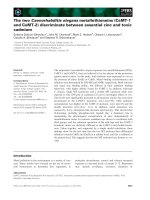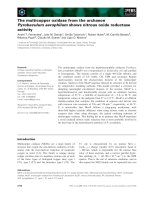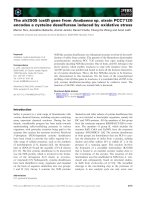Báo cáo khoa học: The N-terminal cysteine pair of yeast sulfhydryl oxidase Erv1p is essential for in vivo activity and interacts with the primary redox centre doc
Bạn đang xem bản rút gọn của tài liệu. Xem và tải ngay bản đầy đủ của tài liệu tại đây (248.37 KB, 8 trang )
The N-terminal cysteine pair of yeast sulfhydryl oxidase Erv1p
is essential for
in vivo
activity and interacts with the primary
redox centre
Go¨ tz Hofhaus
1
, Jeung-Eun Lee
1
, Ivo Tews
2
, Beate Rosenberg
3
and Thomas Lisowsky
3
1
Institut fu
¨
r Biochemie und Biologisch-Medizinisches Forschungszentrum and
3
Botanisches Institut, Heinrich-Heine-Universita
¨
t
Du
¨
sseldorf, Germany;
2
Biochemiezentrum Heidelberg, Germany
Yeast Erv1p is a ubiquitous FAD-dependent sulfhydryl
oxidase, located in the intermembrane space of mito-
chondria. The dimeric enzyme is essential for survival of
the cell. Besides the redox-active CXXC motif close to the
FAD, Erv1p harbours two additional cysteine pairs. Site-
directed mutagenesis has identified all three cysteine pairs
as essential for normal function. The C-terminal cysteine
pair is of structural importance as it contributes to the
correct arrangement of the FAD-binding fold. Variations
in dimer formation and unique colour changes of mutant
proteins argue in favour of an interaction between the
N-terminal cysteine pair with the redox centre of the
partner monomer.
Keywords: sulfhydryl oxidase; mitochondrial Erv1p; redox-
active CXXC; dimer formation; cysteine mutants.
Disulfide bonds are important for the structure and function
of proteins in eukaryotes [1], prokaryotes [2] and even
viruses [3]. Several enzymes are known to catalyse dithiol–
disulfide transfer reactions between proteins, but enzymes
like sulfhydryl oxidases that are capable of synthesizing
disulfide bonds de novo are less common [4]. In general,
these enzymes exist as homodimers, which depend on FAD
as a cofactor, use oxygen as final electron acceptor and
contain a CXXC motif that is involved in the primary
redox-reaction [4,5].
The Saccharomyces cerevisiae protein Erv1p (essential for
respiration and vegetative growth; encoded by the gene
ERV1) and the human homologue Alrp (augmenter of liver
regeneration) are sulfhydryl oxidases in the intermembrane
space of mitochondria [6].
They are found in a large number of different cell-types
and tissues [7]. Their activity is essential for the survival of
the cell, for the biogenesis of mitochondria and for the
supply of cytoplasmic proteins with mitochondrially assem-
bled iron–sulfur clusters [6]. However, their natural sub-
strate proteins are not known today. In yeast, a second
sulfhydryl oxidase, termed Erv2p, has been identified in the
endoplasmic reticulum [8,9]. The N-terminal parts of Erv1p
and Erv2p are very distinct (see Fig. 1). In contrast, the
C-terminal parts of Erv1p and Erv2p, which include the
redox-active centre and the FAD-binding domain, are
similar (30% identity) [10]. Recently, the structure of
a proteolytic fragment of Erv2p, corresponding to the
conserved region, was solved (Fig. 1, 2). A CGC motif at the
very C-terminus was described as part of a flexible arm that
exchanges the de novo synthesized disulfide bridge with
substrate proteins [11]. Members of the mitochondrial Erv1/
Alr protein family lack such a CGC motif (Fig. 1), but
instead consistently contain an additional CXXC motif in
the N-terminal domain. In order to assess the roles of all
individual cysteine residues of Erv1p, we changed them to
serines by site-directed mutagenesis. By working with yeast
Erv1p, this analysis was limited to six cysteines instead of
the nine present in human Alrp and in addition, the mutated
yeast proteins can be easily checked for in vivo activity.
Materials and methods
Strains and plasmids
The following strains of S. cerevisiae were used: JRY 675
(MATa, ura
–
, his4-519, Dleu2) served as wild-type and the
erv1-ts strain was pet492–6 A (MATa,ura3-52,Dleu2;
pet492ts) [12]. The yeast strain with one disrupted copy of
ERV1 was JRY 675, 2n (MATa/MATa, ura3-52/ura3-52,
his4-519/his4-519, Dleu2/Dleu2, ERV1/erv1::LEU2) [12].
Plasmids were: pET-24a(+) (Novagen) and pRS416 [13].
Escherichia coli strains were: DH5-a [14] and BL21(+)
(Novagen).
Gene constructs of ERV1 and
in vitro
mutagenesis
The complete yeast ERV1 gene and a shorter fragment
encoding the 15 kDa C-terminus (DN-Erv1p) have been
cloned into the hexahistidyl-tag vector pET-24a(+) as
described previously [15]. The pET-24a(+) harboring the
complete ERV1 gene was used for site-directed mutagenesis
(PCR-based site-directed mutagenesis kit Excite; Strata-
gene) with the following primers: C30S (forward
5¢-CGATCATGTAACACCCTAC-3¢/reverse 5¢-CGAAG
Correspondence to G. Hofhaus, Institut fu
¨
r Biochemie und Biologisch-
Medizinisches Forschungszentrum, Heinrich-Heine-Universita
¨
t
Du
¨
sseldorf, Universita
¨
tsstraße 1, 40225 Du
¨
sseldorf, Germany.
Fax: + 49 211 81 15310, Tel.: + 49 211 81 15189,
E-mail:
(Received 20 December 2002, revised 4 February 2003,
accepted 12 February 2003)
Eur. J. Biochem. 270, 1528–1535 (2003) Ó FEBS 2003 doi:10.1046/j.1432-1033.2003.03519.x
GTTTGCCATCTTCG-3¢), C33 (forward 5¢-CTACTT
GACTTTCAGTACGTGACC-3¢/reverse 5¢-GGTGGTA
GATGATCGGCAAGGTTTGC-3¢), C130S (forward 5¢-
CCAATTGGTGTGCTAAAGACTTTG-3¢/reverse 5¢-AA
GGATAAATATGTGAGAAGATATTC-3¢), C133 (for-
ward 5¢-CTTTGAAAAATATATCAGAGAAAATG-3¢/
reverse 5¢-TCTTTAGCAGACCAGTTGTAAGG-3¢),
C159S (forward 5¢-GCCCACAATAAAGTCAATAAG
AAAT-3¢/reverse 5¢-CTCAGACATCCACCTCCCAAG
TTCTT-3¢),C176S(forward5¢-CTCCAATTTCTGG
GAAAAAAGATGGAAG- 3¢/reverse 5¢-TCAAATTTGG
GCTTCCTCAATTTC-3¢). Sequences of the primers con-
tained changes of restriction sites that allowed identification
of the successfully mutated plasmids.
Purification of Erv1p-6His proteins from
E. coli
All pET24a(+) constructs were expressed in E. coli strain
BL21(+). The presence of the hexahistidyl-tag at the
C-terminus of the proteins allowed rapid purification with
nickel nitrilotriacetic acid-agarose according to the standard
protocols for the isolation under native conditions in
phosphate buffer (50 m
M
NaCl, 50 m
M
KH
2
PO
4
,10m
M
imidazole, pH 7.5) (Qiagen). Proteins were bound to nickel
agarose and eluted with 50 m
M
NaCl, 50 m
M
KH
2
PO
4
,
200 m
M
imidazole, pH 7.5. Purification to homogeneity
was verified by SDS/PAGE and by Western blot analysis.
Spectroscopy of yeast Erv1p-6His
The visible spectra of the purified proteins in elution buffer
were recorded with an S-10 diode-array photometer (Zeiss).
Under identical conditions a reference of 15 m
M
purified
FAD (Sigma) was measured. To test the reversible reduc-
tion of protein-bound FAD samples of Erv1p and mutant
proteins in elution buffer (300 m
M
imidazole, 50 m
M
phosphate pH 7.5, 200 m
M
NaCl) were completely reduced
with a few grains of Na-dithionite.
Release of protein-bound FAD by heat and acid
treatment
Protein aliquots were adjusted to an A
460
of 0.200 before
releasing the FAD by heat and treatment with 5% trichloric
acetic acid. Denatured proteins were pelleted by centrifu-
gation. Free FAD in the supernatant was determined by
measuring the A
450
. The measurements of the released FAD
were very similar to the values obtained from the A
460
in the
purified proteins. The only exception was the mutant
protein C133S that gave lower values in these experiments
because a substantial amount of the FAD was not liberated
and therefore found in the pellet together with the denatured
protein.
EPR spectroscopy
EPR measurements were conducted with a Brucker EMX
1/6 spectrometer operating at 9.2 GHz. Sample temperature
was maintained at 4 K by an Oxford instruments EPR-9
helium flow cryostat. The magnetic field was calibrated
using strong or weak pitch standard. Spectra of the oxidized
and reduced (dithionite) enzymes were observed.
Enzyme assay for sulfhydryl oxidase activity
Erv1 protein of the full-length and short form and from the
respective cysteine mutants were adjusted to 10 pmol
protein-bound FAD per 100 lL reaction mixture. The
enzyme reaction was started in NaCl/P
i
buffer (68 m
M
NaCl, 75 m
M
potassium phosphate buffer pH 7.5 contain-
ing 3 m
M
EDTA) together with dithiothreitol substrate that
corresponded to 50 nmol reduced thiol groups. Aliquots of
100 lL of this reaction mixture were used for each time
point. For determination of the thiol content the 0.1 mL
samples were diluted with 800 lLofNaCl/P
i
buffer and
then 100 lL5,5¢dithio-bis(2-nitrobenzoic acid) were added
to a final concentration of 10 m
M
. After 2 min the
extinction at 412 nm was measured and the thiol content
was calculated using an extinction coefficient of
14 m
M
)1
Æcm
)1
[16]. The initial content of thiol groups in
the reaction mixture was determined from a sample without
enzyme.
Western analysis
For immunological studies, aliquots with about 200 ng
of purified Erv1p and mutant proteins were applied to
4%-12% nonreducing SDS/polyacrylamide gels (Novex/
Invitrogen). Protein samples were set up with or without
20 m
M
dithiothreitol as indicated. The primary anti-His
5
Ig
(Qiagen) was detected by alkaline phosphatase-conjugated
secondary antibodies and chemiluminescence.
Miscellaneous methods
Plasmid DNA was isolated from E. coli by alkaline lysis and
using the Qiagen kit. Purification, restriction enzyme
digestion, ligation and analysis of DNA or PCR products
on agarose gels were performed as described previously [17].
DNA sequences of all gene constructs were controlled by
completely sequencing the reading frames (MWG-Biotech
company). The modelling and the energy minimizing of the
Fig. 1. Comparison of Erv1p, DN-Erv1p and
Erv2p. The figure displays the corresponding
cysteine residues and identity values for the
N- and the C-terminal parts of the proteins
[8,10]. The hatched area marks the part of
Erv2p whose structure has been solved [11].
Ó FEBS 2003 Cysteine mutagenesis of yeast ERV1 (Eur. J. Biochem. 270) 1529
Erv1p model were carried out using the
WHAT IF
program
[18,19].
Results
The C-terminal FAD binding domain of Erv1p
and Erv2p are conserved
Partial structural information for the homologous Erv2p is
available in the databases [11]. The crystallized protein is a
119 residue proteolytic fragment of Erv2p. This fragment
represents the highly conserved C-terminal region with
an identity of 30% between Erv1p and Erv2p (see Fig. 1).
To investigate whether Erv1p can fold into the same overall
structural assembly, we carried out a modelling study using
the molecular modelling software package
WHAT IF
[18–20].
The high resolution of the 3D structure with 1.5 A
˚
and the
high sequence identity make this study reliable. Briefly,
the sequence of Erv1p was aligned to the Erv2p sequence.
The corresponding Erv1p residues were modelled and the
resulting structure was energy minimized using the software
(Fig. 2)
WHAT IF
[18]. The modelling suggests that Erv1p and
Erv2p can obtain the same structural fold. There are no
clashes of amino acid side chains in the core of the structure,
and most mutations occur on the protein surface. The FAD
binding groove is conserved with most ligand binding
residues identical. However, mutations result in minor
differences in the homodimer interface. A fundamental
difference between the proteins concerns the CGC motif
near the C-terminus of Erv2p. The structure of Erv2p
revealed two possible conformations of the C-terminal arm
with one conformation bringing the cysteine close to the
redox centre of the partner monomer. This finding sugges-
ted that the CGC motif mediates redox shuffling between
the redox centre and possible substrates [11]. This shuffling
mechanism is not possible for Erv1p due to the lack of
cysteines near the C-terminus. However, Erv1p contains an
additional cysteine pair near the N-terminus that could
functionally substitute the CGC motif. Therefore the
systematic functional analysis of the six cysteines in yeast
Erv1p was the major goal of this paper.
All three pairs of cysteines in Erv1p are indispensable
for
in vivo
activity
The six cysteines of yeast Erv1p can be grouped into three
pairs (Fig. 1): one pair near the N-terminus of the protein,
the central pair close to the FAD binding motif and two
cysteines in the C-terminal region that are 17 residues apart.
For our experiments the wild-type ERV1 gene was extended
such that the resultant Erv1p carried six histidine residues at
the C-terminus, facilitating the purification of the proteins
by chromatography on Ni-nitrilotriacetic acid agarose.
Cysteine codons were then successively replaced by serine-
triplets and exchanges were verified by restriction analysis
and sequencing (see Material and methods).
To check the in vivo activity of the mutated proteins we
used a haploid yeast strain with a temperature-sensitive
Erv1 protein [12]. Yeast cells were transformed with single
copy pRS416 constructs containing the genes for the
respective mutated proteins. At elevated temperatures of
36 and 38 °C the temperature-sensitive Erv1p is not
functional and growth therefore depends on the expression
of the genes from the plasmids. The data in Table 1
demonstrate that under these conditions only the wild-type
protein supports growth at 36 °C, the restrictive tempera-
ture for the ts-protein. The only cysteine mutant that is
capable of supporting some growth at elevated temperatures
is C30S. Because Erv1p exists as a dimeric protein in vivo it is
possible that heterodimers between the temperature-sensi-
tive protein and the C30S mutant protein lead to intra-
molecular complementation (see Discussion). To exclude
heterodimer formation, we repeated the experiment using
tetrad analysis of an insertion mutant of the ERV1 gene
(Table 2). The analysis is complicated by recombination
events due to the position of ERV1 close to the centromere,
but the results at higher temperature support the findings of
the first experiments: only the C30S mutation allows some
growth at higher temperatures. Tetrad analysis showed that
Table 1. Complementation studies with erv1-ts. The erv1-ts mutant
(pet492) was transformed with the single copy plasmid pRS416 bearing
the respective Cys mutants (exchange of Cys against Ser: C-S) of
ERV1. Complementation activity (+ growth/– no growth) was tested
on glucose complete medium at 28, 36 or 38 °C after 4 days.
Yeast strain
Temperature (°C)
28 36 38
Wild-type + + +
erv1-ts + – –
erv1-ts + Erv1p C30S + + –
erv1-ts + Erv1p C33S + – –
erv1-ts + Erv1p C130S + – –
erv1-ts + Erv1p C133S + – –
erv1-ts + Erv1p C159S + – –
erv1-ts + Erv1p C176S + – –
Table 2. Complementation studies with Derv1. The diploid strain
Derv1/ERV1 was transformed with the single copy plasmid pRS416
bearing the respective Cys mutants (exchange of Cys against Ser: C-S)
of ERV1. After tetrad dissection complementation activity
(+ growth/– no growth) for the haploid Derv1wastestedonglucose
complete medium at 28, 36 or 38 °C after 4 days. Due to the close
association of the ERV1 gene with the centromere frequent abnormal
recombination between the genomic copy and the plasmid encoded
ERV1 gene were observed. Therefore only complete tetrads with cor-
rect genetic markers were used for evaluation of the phenotype listed in
Table 2.
Yeast strain
Temperature (°C)
28 36 38
Wild-type + + +
Derv1 – – –
Derv1 + Erv1p C30S + – –
Derv1 + Erv1p C33S – – –
Derv1 + Erv1p C130S – – –
Derv1 + Erv1p C133S – – –
Derv1 + Erv1p C159S + – –
Derv1 + Erv1p C176S + – –
1530 G. Hofhaus et al. (Eur. J. Biochem. 270) Ó FEBS 2003
at 28 °C the mutants C30S, C159S and C176S displayed a
residual activity that allows survival, whereas the mutants
C33S, C130S and C133S had no complementation activity.
To investigate the in vitro activity of the enzyme, the
mutagenized genes were overexpressed in E. coli and the
proteins were purified to homogeneity taking advantage of
the His-tag. In contrast to earlier activity measurements,
sulfhydryl oxidase activity was measured with dithiothreitol,
which was a good substrate in NaCl/P
i
([21] and Material
and methods). Due to the sulfhydryl oxidase activity the
dithiothreitol is oxidized. At different time points, the
remaining free thiol groups of the substrate were quantified
with Ellman’s reagent [16]. The initial slope of the time
course was used to calculate the turnover numbers for
mutated and wild-type proteins. As shown in Fig. 3, most of
the mutated proteins show no or strongly diminished in vitro
sulfhydryl oxidase activities. Exchange of the two cysteine
residues in the N-terminal part of the proteins seems to
interfere with but not abolish the activity. It has been
reported in previous studies that the N-terminally truncated
form of Erv1p has the same in vitro activity as the wild-type
enzyme with artificial substrates such as dithiothreitol or
reduced lysozyme [15]; nevertheless, truncated Erv1p is not
able to replace wild-type Erv1p in vivo [22].
C30 and C33 are involved in dimer formation
Erv1p is isolated as a homodimer from yeast cells [15]. The
dimeric form is probably important for function. SDS/
PAGE has shown that the dimer is stabilized by a disulfide
bond that keeps the two monomers covalently linked under
nonreducing conditions [15]. While the wild-type proteins
exist as a mixture of dimers and monomers under these
conditions, the DN-Erv1p is found exclusively in the
monomeric form (Fig. 4). This already demonstrates the
importance of the N-terminal domain for dimer-formation.
Under nonreducing conditions all of the cysteine mutant
proteins display only a small amount of monomeric form
Fig. 3. Sulfhydryl oxidase in vitro activity of Erv1p and mutated
enzymes. Activities of the purified enzymes were measured with
dithiothreitol as an artificial substrate (for details see Materials and
methods). Turnover numbers were calculated per protein-bound
FAD molecule as determined spectroscopically. Three independ-
ent measurements were performed for each enzyme preparation
and the respective mean values were listed. SD are given by black
bars.
Fig. 2. The functional dimer of the proteolytic Erv2p fragment as determined by X-ray crystallography (pdb accession no. 1JR8 [11]) is presented. One
monomer of the dimeric protein is shown in blue, the second monomer is presented in a simplified sketch (grey). Cysteine residues and the FAD are
displayed in different shades of yellow. The C-terminal CGC motif (C176–C178) is in proximity to the postulated active site of the partner monomer
and hence could participate in thiol-exchange. The modelled structure of the corresponding C-terminal part of Erv1p (red) is displayed on the right
side of the figure. A C-terminal CGC motif is missing in Erv1p.
Ó FEBS 2003 Cysteine mutagenesis of yeast ERV1 (Eur. J. Biochem. 270) 1531
with the exception of C133S. In comparison to the wild-
type protein the C30S, C33S and to a lesser extend the
C130S mutant proteins are predominantly found in the
dimeric form. The absence of a high molecular smear
points to proper protein folding of these mutants in
contrast to mutants C133S, C159S and C176S that exhibit
high molecular mass aggregates indicating nonspecific
aggregation.
Unique colour changes of the protein are associated
with the exchange of certain cysteine residues
for serine
So far, the analysis has revealed the importance of all
cysteine residues in the protein, but has not given any clues
to their molecular function. Luckily, some mutations
resulted in interesting colour changes. The wild-type protein
and the short form of the protein exhibit an intensive yellow
colour, due to the bound FAD (Fig. 5). The two most
striking changes upon cysteine exchange are the black
appearance of the C30S protein and the orange colour of
the C130S mutant. Changing the other cysteine within these
pairs did not result in matching colour changes. While the
mutation C30S resulted in a black protein, C33S produced a
wild-type colour; the orange colour of C130S is contrasted
by the pale C133S and exchange of C159 against serine
produced a colourless protein, while the exchange C176S
resulted in a wild-type appearance. These diverse colour
changes point to different biophysical properties of the two
cysteines within all three pairs.
The colour changes were analysed in more detail by
spectroscopy. The C30S mutant revealed an additional
absorbance around 580 nm, while for the C130S mutant
the FAD peak around 460 nm seems to be broadened
(Fig. 6). The spectra of the remaining coloured mutant
proteins (not shown) were indistinguishable from the
spectra of the wild-type protein whereas the colourless
proteins did not exhibit maxima typical for FAD. EPR
spectroscopy gave no indications of radicals or metals
bound to the proteins (data not shown). All colours
disappeared after reduction with dithionite. Upon reoxida-
tion of the solution in air, the yellow wild-type colour
appeared. Likewise, upon storage for several days the
appearance of the mutated proteins turned towards the
Fig. 4. Dimer formation of Erv1p and mutant
proteins. Purified proteins were separated on a
nonreducing SDS/PAGE with (+) or without
(–) 20 m
M
dithiothreitol in the sample buffer.
Detection of protein bands was carried out
with a His
6
-antibody and chemiluminescence.
Fig. 5. Colours of purified Erv1p and mutant proteins. Protein
concentrations vary due to different expression levels of the
mutant proteins in E. coli. Erv1p (5.9 mgÆmL
)1
), C30S (36 mgÆmL
)1
),
C33S (10.8 mgÆmL
)1
) C130S (14.1 mgÆmL
)1
), C133S (4.1 mgÆmL
)1
),
C159S (9.9 mgÆmL
)1
), C176S (6.0 mgÆmL
)1
), DN-Erv1p
(4.1 mgÆmL
)1
).
Fig. 6. Spectra for wild-type Erv1p, C30S and C130S. Purified proteins
were analysed in a Zeiss S10 diode-array spectrophotometer. The
absorption between 320 and 700 nm is shown. Spectra are interpreted
qualitatively only because the FAD content is different and the molar
absoprtion coefficient might be different for mutant proteins. Protein
concentrations are: 2.2 mgÆmL
)1
(Erv1p), 5.1 mgÆmL
)1
(C30S) and
4.2 mgÆmL
)1
(C130S).
1532 G. Hofhaus et al. (Eur. J. Biochem. 270) Ó FEBS 2003
wild-type colour, possibly due to oxidation by air. So far,
we have not been able to restore the initial colour of the
mutant protein once it is lost.
Calculation of the FAD content of the purified mutant
proteins turned out to be difficult due to variations in FAD/
protein ratios of the recombinant proteins. Control experi-
ments with liberated FAD from heated and acid-treated
samples gave similar values. It appears that growth
conditions and gene expression of the recombinant proteins
cause the variations. A reproducible qualitative finding was
that C133S and C159S always contained a substantially
lower amount of protein-bound FAD than all other mutant
proteins. The FAD content of the mutants C30S and C33S
were similar to that of the wild-type proteins arguing
against a general misfold of the proteins caused by the
mutations.
Discussion
The CXXC motif at the reaction centre is indispensable
for the interaction with FAD
The interpretation of the observed colour changes is
facilitated by the available structural data for Erv2p [11].
As can be deduced from Fig. 1 the crystallized part of Erv2p
contains the conserved FAD-binding domain and four of
the six cysteines present in Erv1p. The structure (see Fig. 2)
reveals that the redox-active residues C130, C133 are in
close proximity to the FAD, with the C-terminal cysteine
(C133) being closer to the flavin structure. For the reduced
central CXXC motif an intermediate has been suggested
[23], where a thiol anion is stabilized by a charge-transfer-
complex with the bound FAD. Subsequently, the FAD is
reduced and a disulfide bridge is formed between the
cysteines. Replacement of C130 by serine interferes with the
second step and thereby may stabilize the charge transfer
complex of C133 with the FAD resulting in the orange
colour of the mutant protein. However, a similar colour
change was not reported for the replacement of the
corresponding cysteine by alanine in Erv2p [11]; thus it is
possible that the serine residue also contributes to colour
formation. In any case, the overall reaction is impaired and
the mutated enzyme does not show any activity in vitro or
in vivo. This phenotype is in agreement with the finding that
the C130–C133 pair is part of the primary redox-active
centre.
Cysteine 159 and 176 stabilize the FAD-binding domain
The second pair of cysteines in the crystallized part of
Erv2p is separated by 17 residues and the exact distance is
found between the corresponding cysteines of Erv1p. The
reason for this exact match is clear from the structure of
Erv2p, because the disulfide bridge between these residues
has to tether the short helix 5 to the four-helix-bundle [11].
Replacing C159 by a serine destroys the disulfide bridge
and the introduction of a polar group probably interferes
with binding of the adenine portion of the FAD that is
normally attached to this region of the protein. Conse-
quently, the capability of the mutant protein for binding
FAD is affected. Although the corresponding exchange of
C176S destroys the same disulfide bridge, it has a less
drastic effect. Due to its more peripheral position in a part
of the protein without a pronounced secondary structure,
this introduced serine might be accommodated without
disturbing the FAD binding too much. Although FAD is
bound to the protein, structural adjustments are not
perfect, as shown by the low in vitro enzymatic activity.
In agreement with this, one also observes a temperature-
sensitive in vivo activity (Table 2).
The N-terminal CXXC motif is essential for the function
of Erv1p
in vivo
Like DN-Erv1p, the C33S mutant protein cannot function-
ally replace the wild-type enzyme in vivo. At least for the
point mutation, localization in an incorrect subcellular
compartment is unlikely to explain this finding. The similar
FAD binding and the absence of unspecific, large aggregates
on the SDS/PAGE argue against a general misfold of the
protein. Thus, the fact that the mutant cannot complement
the wild-type enzyme in vivo (Tables 1 and 2) provides
genetic evidence for an essential involvement of the
N-terminal cysteine pair in the in vivo function.
A possible function of this N-terminal CXXC motif in
Erv1p is suggested by the discovery of a CGC motif as
part of the flexible C-terminal arm in the related Erv2p
[11]. In one conformation, this arm brings the CGC close
to the redox-active centre of the other monomer, while in
the second conformation the arm reaches out to the
open space. Thus, the CGC motif on the flexible arm
might exchange the de novo synthesized disulfides from
the CXXC motif of the primary redox-active centre and
passes them on to specific substrates. Erv1p lacks the
C-terminal CGC motif, but possesses the additional
CXXC motif near the N-terminus. Based on the
structure of Erv2p the authors have already speculated
that in Erv1p the N-terminal domain could fulfil the task
of a flexible arm [11]. Our data present several new lines
of evidence supporting this idea.
As shown for the Erv2 protein, the dimer formation
depends on an interaction of the CGC motif with the
CXXC motif of the opposite monomer. The short form of
the Erv1 protein, which lacks the N-terminal pair of
cysteines, does not form any dimers. This is not due to a
general misfolding of the short Erv1p because FAD binding
and in vitro enzyme activity are unchanged. Changing C30
or C33 to serine drastically increases the amount of
observed dimers. Probably, the remaining single cysteine
residue interacts with the CXXC motif at the reaction centre
of the opposite monomer. Due to the mutation, the reaction
of the mutant protein gets trapped halfway and the two
monomers are permanently crosslinked, explaining the
increased amount of dimers.
The C30 mutation drastically changes the colour of the
protein. EPR spectroscopy gave no indication for radicals
or metals bound to the protein. On the other hand, the
colour of the protein is completely bleached upon reduc-
tion with dithionite. Thus, we conclude, that the serine
introduced at position 30 is close enough to the reaction
centre to change the spectroscopic characteristics of the
FAD or the charge-transfer complex. One possible explan-
ation would be a charge-transfer complex between a
persulfide anion and the FAD, that causes a similar colour
Ó FEBS 2003 Cysteine mutagenesis of yeast ERV1 (Eur. J. Biochem. 270) 1533
change in the FAD containing butyryl-CoA dehydrogenase
[24]. Again, the change to serine might contribute to colour
production as no colour changes were reported for the
corresponding alanine mutations of Erv2p. While a detailed
band analysis and FT-IR might reveal more about the exact
interactions at the reaction centre, we take the colour
change of C30S as strong evidence for physical interactions
of the N-terminal cysteine pair with the primary reaction
centre. The situation in the C33S mutation appears to be
different with respect to the intermediate formed. Biophys-
ical differences between the cysteine residues of redox active
CXXC motives are well known and it might be speculated,
that C33 is the stronger nucleophile that therefore initiates
the transfer reaction with other cysteine residues [4,5].
Deletion of the N-terminal Erv1p domain does not
disturb the reaction with artificial substrates like dithio-
threitol. In contrast, the two point mutations C30S/C33S
reduce the in vitro activity. The most plausible explanation
for this finding is that the changes of cysteine 30 or 33 to
serine may result in unproductive contacts with the primary
redox centre of the partner monomer as demonstrated by
the increased dimer formation (Fig. 4).
The analogous bacterial compartment of the mitochond-
rial intermembrane space has developed similar strategies
for the transfer of disulfide bridges. It has recently been
reported that the bacterial dsbB protein in the periplasm
also contains two cysteine pairs acting in concert for the
transfer of disulfides to dsbA [25]. Interestingly, the redox
function of dsbB is linked to the bacterial respiratory chain
[26,27], providing another clue for the localization of Erv1p
in the mitochondrial intermembrane space.
The presented genetic, biochemical and spectroscopic
data indicate a possible involvement of the flexible
N-terminal arm for intersubunit disulfide transfer. While
final proof could possibly only be achieved by structural
information, it will be interesting to identify the natural
substrates, which may be proteins or iron–sulfur clusters
within proteins that due to structural restrictions depend
solely on a flexible arm for the transfer of disulfide bridges.
Acknowledgements
The help of Dr Thorsten Friedrich with the EPR experiments and for
reading the manuscript are gratefully acknowledged. For critical
reading and useful suggestions we thank Dr Robert N. Lightowlers. We
thank Martin Ingenhoven for help with the preparation of the mutant
proteins. The authors acknowledge support of their work by the
Deutsche Forschungsgemeinschaft (DFG) (Grant SFB 575).
References
1. Kadokura, H. & Beckwith, J. (2001) The expanding world of
oxidative protein folding. Nat. Cell Biol. 3, E247–E249.
2. Ritz, D. & Beckwith, J. (2001) Roles of thiol-redox pathways in
bacteria. Annu. Rev. Microbiol. 55, 2001.
3. Senkevich, T.G., White, C.L., Koonin, E.V. & Moss, B. (2000) A
viral member of the ERV1/ALR protein family participates in a
cytoplasmic pathway of disulfide bond formation. Proc. Natl
Acad. Sci. USA 97, 12068–12073.
4.Hoober,K.L.,Glynn,N.M.,Burnside,J.,Coppock,D.L.&
Thorpe, C. (1999) Homology between egg white sulfhydryl oxi-
dase and quiescin Q6 defines a new class of flavin-linked sulfhydryl
oxidases. J. Biol. Chem. 274, 31759–31762.
5. Thorpe, C., Hoober, K.L., Raje, S., Glynn, N.M., Burnside, J.,
Turi, G.K. & Coppock, D.L. (2002) Sulfhydryl oxidases: emerging
catalysts of protein disulfide bond formation in eukaryotes. Arch.
Biochem. Biophys. 405, 1–12.
6. Lange,H.,Lisowsky,T.,Gerber,J.,Mu
¨
hlenhoff, U., Kispal, G. &
Lill, R. (2001) An essential function of the mitochondrial sulf-
hydryl oxidase Erv1p/ALR in the maturation of cytosolic Fe/S
proteins. EMBO Report 2, 715–720.
7. Klissenbauer, M., Winters, S., Heinlein, U.A.O. & Lisowsky, T.
(2002) Accumulation of the mitochondrial form of the sulfhydryl
oxidase Erv1p/Alrp during early stages of spermatogenesis. J. Exp.
Biol. 205, 1979–1986.
8. Sevier, C.S., Cuozzo, J.W., Vala, A., Aslund, F. & Kaiser, C.A.
(2001) A flavoprotein oxidase defines a new endoplasmic
reticulum pathway for biosynthetic disulphide bond formation.
Nat. Cell Biol. 3, 874–882.
9. Gerber,J.,Mu
¨
hlenhoff, U., Hofhaus, G., Lill, R. & Lisowsky, T.
(2001) Yeast ERV2p is the first microsomal FAD-linked sulf-
hydryl oxidase of the Erv1p/Alrp protein family. J. Biol. Chem.
276, 23486–23491.
10. Stein, G. & Lisowsky, T. (1998) Functional comparison of the
yeast scERV1 and scERV2 genes. Yeast 14, 171–180.
11. Gross, E., Sevier, C.S., Vala, A., Kaiser, C.A. & Fass, D. (2002) A
new FAD-binding fold and intersubunit disulfide shuttle in the
thiol oxidase Erv2p. Nat. Struct. Biol. 9, 61–67.
12. Lisowsky, T. (1992) Dual function of a new nuclear gene for
oxidative phosphorylation and vegetative growth in yeast. Mol.
Gen. Genet. 232, 58–64.
13. Mumberg, D., Mu
¨
ller, R. & Funk, M. (1994) Regulatable pro-
moters of Saccharomyces cerevisiae: comparison of transcriptional
activity and their use for heterologous expression. Nucleic Acids
Res. 22, 5767–5768.
14. Hanahan, D. (1983) Studies on transformation of Escherichia coli
with plasmids. J. Mol. Biol. 166, 557–580.
15. Lee, J., Hofhaus, G. & Lisowsky, T. (2000) Erv1p from Sac-
charomyces cerevisiae is a FAD-linked sulfhydryl oxidase. FEBS
Lett. 477, 62–66.
16. Riddles, P.W., Blakely, R.L. & Zerner, B. (1979) Ellman’s reagent:
5,5¢-dithiobis(2-nitrobenzoic acid) – a re-examination. Anal. Bio-
chem. 94, 75–81.
17. Sambrook, J., Fritsch, E.F. & Maniatis, T. (1989) Molecular
Cloning: A Laboratory Manual. Cold Spring Harbor Press, Cold
Spring Harbor, New York.
18. Vriend, G. (1990) WHAT IF: a molecular modeling and drug
design program. J. Mol. Graph. 8, 52–56.
19. Sato, S., Tews, I. & Wilson, R.J. (2000) Impact of a plastid-bearing
endocytobiont on apicomplexan genomes. Int. J. Parasitol. 30,
427–439.
20. Tews,I.,Perrakis,A.,Oppenheim,A.,Dauter,Z.,Wilson,K.S.&
Vorgias, C.E. (1996) Bacterial chitobiase structure provides insight
into catalytic mechanism and the basis of Tay-Sachs disease. Nat.
Struct. Biol. 3, 638–648.
21. Hoober, K.L., Sheasley, S.L., Gilbert, H.F. & Thorpe, C. (1999)
Sulfhydryl oxidase from egg white. A facile catalyst for disulfide
bond formation in proteins and peptides. J. Biol. Chem. 274,
22147–22150.
22. Lisowsky, T. (1996) Removal of an intron with unique 3¢
branch site creates an amino-terminal protein sequence direct-
ing the scERV1 gene product to mitochondria. Yeast 12, 1501–
1510.
23. Hoober, K.L. & Thorpe, C. (1999) Egg white sulfhydryl oxidase:
kinetic mechanism of the catalysis of disulfide bond formation.
Biochemistry 38, 3211–3217.
24. Williamson, G., Engel, P.C., Mizzer, J.P., Thorpe, C. & Massey, V.
(1982) Evidence that the greening ligand in native butyryl-CoA
dehydrogenase is a CoA persulfide. J. Biol. Chem. 257, 4314–4320.
1534 G. Hofhaus et al. (Eur. J. Biochem. 270) Ó FEBS 2003
25. Kadokura, H. & Beckwith, J. (2002) Four cysteines of the mem-
brane protein DsbB act in concert to oxidize its substrate. EMBO
J. 15, 2354–2363.
26. Bader, M.W. & Xie, T., Yu, C.A. & Bardwell, J.C. (2000)
Disulfide bonds are generated by quinone reduction. J. Biol.
Chem. 275, 26082–26088.
27. Kadokura, H., Bader, M., Tian, H., Bardwell, J.C. & Beckwith, J.
(2000) Roles of a conserved arginine residue of DsbB in
linking protein disulfide-bond-formation pathway to the respira-
tory chain of Escherichia coli. Proc.NatlAcad.Sci.USA97,
10884–10889.
Ó FEBS 2003 Cysteine mutagenesis of yeast ERV1 (Eur. J. Biochem. 270) 1535



